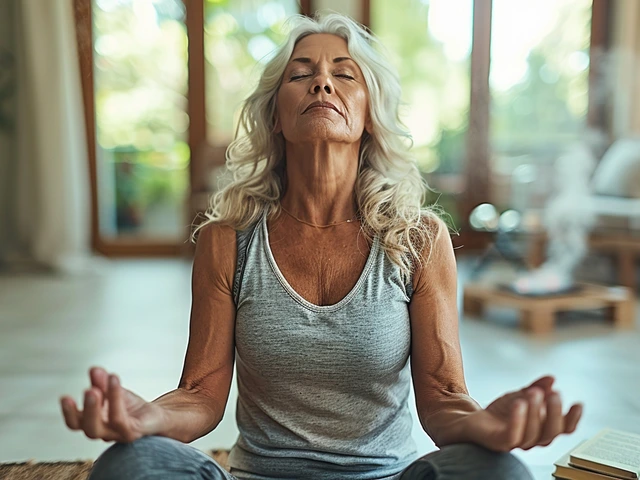Boost Energy with Thai Massage - Natural Wellness Tips

Thai Massage Frequency Calculator
Find out how often you should get a Thai massage to maximize your energy levels based on your activity level and health status.
Quick Takeaways
- Thai massage blends assisted yoga stretches, rhythmic pressure, and deep‑tissue work to jump‑start your body.
- It stimulates circulation, lymphatic flow, and key hormonal pathways that lift energy levels - the body’s overall feeling of vitality and stamina.
- Regular sessions can lower cortisol, raise endorphins, and improve fascia flexibility, all of which translate to more alertness.
- Hydration, mindful breathing, and post‑massage movement lock in the benefits for longer periods.
- Most healthy adults can safely enjoy Thai massage twice a week; people with certain medical conditions should consult a professional first.
When it comes to natural ways to revitalize your body, Thai massage is a traditional healing art that blends assisted yoga stretches, rhythmic pressing, and deep‑tissue work to address both muscular tension and energetic flow. Originating from ancient Thai medicine, the practice treats the body like a network of interconnected pathways rather than isolated muscles. By moving along those pathways, the therapist can release blockages, improve blood and lymph movement, and ultimately give your energy a noticeable lift.
How Thai Massage Works
The core philosophy rests on the idea that energy - called "chi - the life‑force that circulates through meridians in traditional Asian medicine - flows best when muscles, joints, and fascia are receptive. A typical 90‑minute session follows three stages:
- Warm‑up: Light palm pressure awakens the circulatory system.
- Assisted stretches: The therapist gently guides the client into yoga‑like positions, opening joint capsules and lengthening fascia - the connective tissue that wraps muscles, organs, and bones.
- Deep rhythmic pressing: Thumb, forearm, and elbow pressure targets acupressure points - specific nodes along the meridians that correspond to organ function and hormonal balance.
Each movement is coordinated with the client’s breathing, encouraging a flow of oxygen that fuels the metabolic processes behind natural energy production.
Why It Impacts Energy
Energy in the body isn’t just a vague feeling; it’s a measurable interaction of hormones, blood flow, and nerve signaling. Thai massage influences three key biochemical players:
- Endorphins: The body’s natural painkillers, released when pressure stimulates skin receptors. Higher endorphin levels reduce perceived fatigue.
- Cortisol: Known as the stress hormone, cortisol spikes drain stamina. Gentle rhythmic strokes have been shown to lower cortisol by up to 30% in a single session.
- Oxygen‑rich blood: Improved circulation - the movement of blood through vessels and capillaries delivers more oxygen to mitochondria, the cell’s power plants.
When these factors align - more endorphins, less cortisol, better oxygen delivery - the brain signals a higher level of alertness and physical readiness, which we experience as an energy boost.
Key Techniques That Raise Energy
Not every Thai massage move targets energy equally. The most effective for a stamina surge are:
- Therapeutic stretching: Lengthening fascia improves the elasticity of muscles, allowing them to contract more efficiently during daily activities.
- Pulsating pressure on the solar plexus: This central acupressure spot influences the adrenal glands, which release adrenaline and norepinephrine - natural energizers.
- Foot and leg sweeps: Stimulating the lower limb meridians gets the lymphatic flow - the system that clears metabolic waste and supports immune function moving. Cleaner blood means less fatigue.
- Head and neck rocking: Light rhythmic motions around the cervical spine encourage cerebrospinal fluid circulation, sharpening mental clarity.
Each of these motions is synchronized with deep diaphragmatic breathing, a simple but powerful way to raise blood‑oxygen levels on the spot.

The Body Systems Stimulated
Think of your body as a set of interlocking circuits. Thai massage touches several at once:
- Cardiovascular system: The rhythmic pushes and pulls increase heart rate slightly, training the heart to pump more efficiently.
- Lymphatic system: Gentle oscillations along the legs and arms act like a pump, encouraging lymph fluid to flow and remove cellular debris that can cause sluggishness.
- Musculoskeletal system: Stretching releases tight bands in fascia, allowing muscles to move with less resistance.
- Respiratory system: Coordinated breathing during the session expands lung capacity and improves oxygen uptake, a direct fuel source for energy.
- Nervous system: Pressure on acupressure points triggers parasympathetic activation, which balances the sympathetic “fight‑or‑flight” response that often leaves us feeling drained.
Because these systems are linked, a modest improvement in one often cascades into the others, creating a compound effect on overall vitality.
Practical Session Guide
If you’re booking your first Thai massage with the aim of boosting energy, here’s a step‑by‑step rundown of what to expect and how to prepare:
- Pre‑session hydration: Drink a glass of water 30 minutes beforehand. Hydration supports the lymphatic system’s ability to flush toxins.
- Dress comfortably: Wear loose clothing that allows easy movement. Thai massage is usually performed on a mat on the floor, so you’ll stay clothed.
- Communicate goals: Tell the therapist you’re looking for an “energy boost.” They can tailor the pressure and focus on the solar plexus, legs, and upper back.
- During the session: Follow the therapist’s cue to breathe deeply. Inhale through the nose, exhale through the mouth, matching the rhythm of each stretch.
- Post‑session movement: Walk gently for five minutes to keep circulation flowing. Light stretching of the arms and hips helps lock in the benefits.
- Post‑session nutrition: Have a light snack rich in protein and complex carbs (e.g., a banana with nut butter) within an hour to fuel the newly‑energized muscles.
Most clients report feeling a light, “wired‑but‑relaxed” sensation that lasts for 4‑6hours. If you schedule regular sessions, the boost can become a part of your weekly rhythm.
Tips to Maximize the Energy Boost
- Stay hydrated throughout the day: Aim for at least 2liters of water, especially after the massage.
- Practice diaphragmatic breathing: Three minutes of deep belly breaths twice a day sustains the oxygen surge.
- Combine with light cardio: A 20‑minute walk or gentle jog the day after the massage amplifies circulation benefits.
- Mindful rest: Avoid heavy meals or alcohol within two hours of the session; they can counteract the hormonal balance.
- Consistency is key: Aim for two 60‑minute sessions per week to keep cortisol low and endorphins high.
Safety & Contraindications
Thai massage is generally safe, but it does involve forceful stretches and pressure. You should avoid or modify sessions if you have:
- Severe osteoporosis or bone fractures.
- Acute inflammation, recent surgeries, or open wounds.
- Pregnancy beyond the first trimester (certain positions may be risky).
- Uncontrolled hypertension or heart conditions - discuss with your doctor first.
Always inform the therapist about any medical conditions; a qualified practitioner will adjust the intensity accordingly.
Experience the Power of Thai massage for Lasting Energy
Integrating Thai massage into your wellness routine is a simple, drug‑free way to upgrade your daily stamina. By targeting circulation, lymphatic flow, and key hormonal pathways, the practice turns a 90‑minute session into a catalyst for long‑lasting vigor. Whether you’re a busy professional, a student pulling late‑night study sessions, or anyone who feels a mid‑day slump, the combination of assisted stretches, rhythmic pressure, and mindful breathing can give you the natural lift you’ve been searching for.

Frequently Asked Questions
How often should I get a Thai massage to see an energy boost?
Most people notice a lift after a single 60‑90 minute session. For sustained benefits, two sessions per week for a month is a good baseline. Adjust frequency based on how your body feels and any schedule constraints.
Can I combine Thai massage with other forms of exercise?
Absolutely. Light cardio or yoga the day after a Thai massage improves circulation and helps lock in the fascia‑loosening effects. Just avoid high‑intensity workouts immediately after a session to give muscles time to recover.
Is Thai massage safe for people with high blood pressure?
Mild to moderate pressure is usually fine, but it’s essential to inform the therapist about your condition. They can avoid deep compressions near the neck and focus on gentle stretches that won’t spike blood pressure.
Do I need to be flexible to benefit from Thai massage?
No. The therapist supports every movement, so even beginners can experience the energy‑boosting effects. Flexibility often improves after regular sessions.
What should I eat after a Thai massage for maximum energy?
A balanced snack with protein and complex carbs-like Greek yogurt with berries or a whole‑grain toast with avocado-provides the nutrients needed to sustain the post‑massage metabolic boost.





